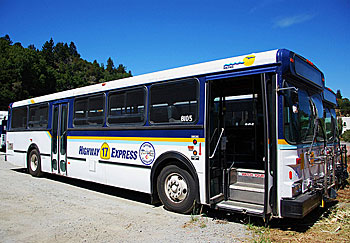The Key to Transit in Santa Cruz County
The Second of three articles on the future of transportation in Santa Cruz County
By Noel Smith
Mass Transit and the Metro

However, rail mass transit is at least ten-fifteen years away from being implemented. Until then, the Metro will have to act as both our local and long distance means of public transit. Alex Clifford is the new (One year in office) CEO/General Manager of the Santa Cruz Metropolitan Transit District. His job is to make the Metro relevant to the transportation needs of the public and to make the public aware that the Metro is a viable alternative when planning their daily travels.
Metro Buses
Clifford said that the environmental requirements for diesel engines keep getting more complex and expensive while the CNG (Compressed Natural Gas) “Clean Air Buses” don’t have the reliability or longevity of diesel buses.
The newest zero emissions bus technology now becoming available are autonomous (Self Powered) electric buses. The range of this new generation of transit buses is about 200 miles without recharge. But there are also ways to quick-charge the bus while it is sitting at a transit center. A test of an electric bus on the Highway 17 Express route round trip showed that with regenerative braking, it had 68% of a full charge left before recharging. The purchase cost of these new autonomous electric buses is more than fuel powered buses but reductions in the operational costs are expected to more than make up the difference during its operational lifetime.
Local and Commute Travel
The difficulty with using the freeway as a commute corridor for buses is that when traffic is stopped, so are the buses. However, Clifford said that the Metro and the Santa Cruz County Regional Transportation Commission are looking at the ‘Bus on Shoulder’ (BOS) system. This would allow transit buses to operate on the shoulders of selected sections of freeways during periods of congestion in order to bypass traffic and maintain transit schedules. The Bus on Shoulder system is a low-cost approach that can provide immediate benefits to improve transit and commuter travel during moderate to heavy degrees of freeway congestion.
Renovating Metro Transit Centers
Metro is planning to renovate both its Santa Cruz and Watsonville Transit Centers. The Watsonville location will be expanded to handle eight buses at the center and provide more amenities for its riders. The Santa Cruz Transit Center will be reconfigured to include more retail area, a community room, and residential units. Metro is now considering coordinating the Center’s design and construction with a neighboring property redevelopment, which could provide cost and time to build reductions for the project.
Planning for the Future
With its new management and planning staff, Santa Cruz Metro may be ready to become the visible travel alternative to the automobile that this county has needed. But the challenge to local transportation is whether it is improving our roads and highways, modernizing the Metro, or constructing a new mass transit rail system, they all take money; a major investment by our community to get our county out of its physical and political transportation gridlock in order to build for the future.
Next Month: Roads and Highways and Building for the Future